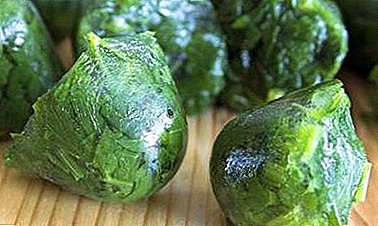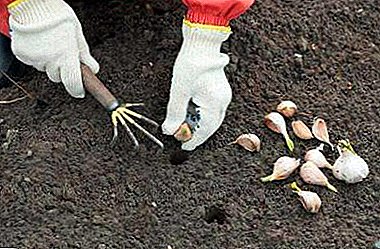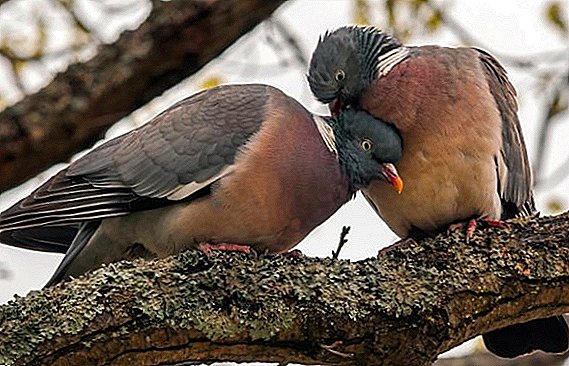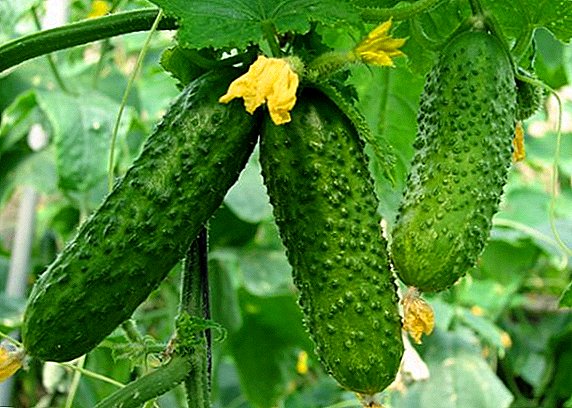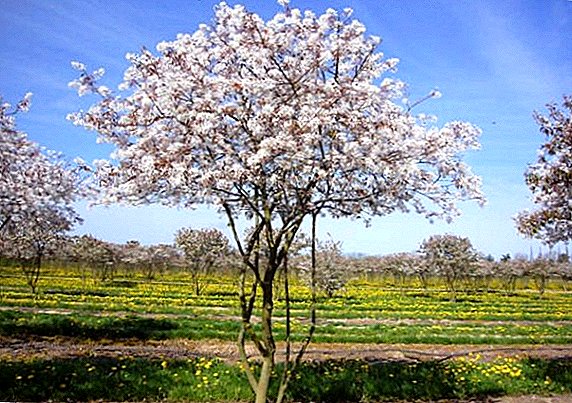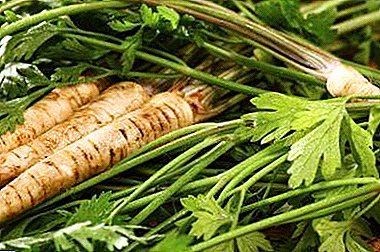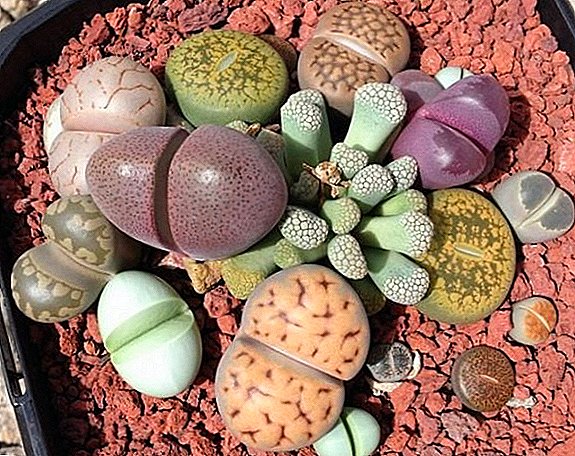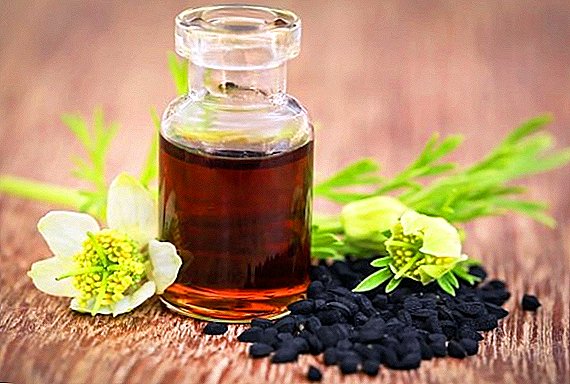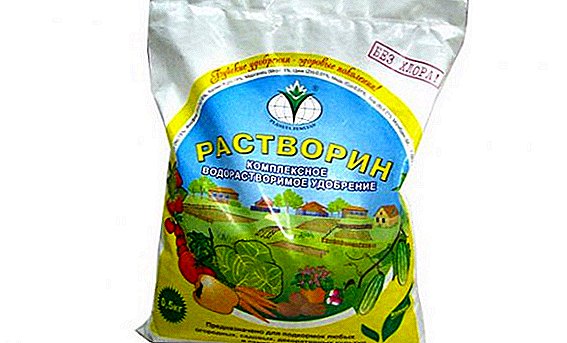 For fertilizing the soil and feeding the developing plants, the complex fertilizer “Mortar” is well suited, which has a balanced composition of the main useful plant substances, and its application is universal.
For fertilizing the soil and feeding the developing plants, the complex fertilizer “Mortar” is well suited, which has a balanced composition of the main useful plant substances, and its application is universal.
Description and composition
"Dissolved" is a fertilizer in the form of white granules with a small amount of powder, the composition of which is easily soluble in water for use in liquid form.  Manufacturers produced four varieties with indices A, A1, B and B1. Such marking is applied due to the fact that with a standard set of substances useful to plants, their percentage in the total mass is not the same.
Manufacturers produced four varieties with indices A, A1, B and B1. Such marking is applied due to the fact that with a standard set of substances useful to plants, their percentage in the total mass is not the same.
You will be interested to learn more about such complex fertilizers as: "Crystal", "Kemira", mineral fertilizers.The number of main components in the mixture is as follows:
- from 18 to 28% potassium;
- 8-18% nitrogen;
- 5-18% phosphorus;
- 0.1% manganese;
- 0.01% boron;
- 0.01% copper;
- 0.01% zinc;
- 0.001% molybdenum.
 Retail packaging has various forms.:
Retail packaging has various forms.:- bags from 15 g;
- packages from 100 g;
- plastic buckets from 1 kg;
- bags up to 25 kg.
Did you know? "Mortar" completely safe for plants and people, because it lacks chlorine.It is used for spring soil fertilization and further fertilizing of individual plants. Is suitable for use on the open soil, in hotbeds and greenhouses, for houseplants. Application to the soil or top dressing is carried out by a method of watering or spraying.
Influence and properties
The universal composition "Mortar", which quickly and easily connects with water, allows you to use it for the following purposes:
- saturation of depleted soil with useful substances, microelements and vitamins;
- stimulate the growth and development of plants, which reduces the time to obtain a rich harvest;
- periodic feeding of the root system of plants when grown in a confined space;
- foliar feeding through the stems and leaves of balanced substances that are fully absorbed by plants;
- supporting the plant when it is treated with diseases and pests;
- the exclusion of additional excavation work, such as digging.

Important! The separation of brands A, A1, B, B1, allows you to use exactly the fertilizer, which composition is most suitable for the current stage of plant development.
How to prepare a solution
On each package "Mortar" there is an instruction for its preparation and use. But since it is sometimes incomplete, you should read the following information:
- the solution is prepared in a conventional bucket with a capacity of at least ten liters by the method of mixing;
- water for solution is taken from wells or wells, the ideal option is rainwater collected in a special container;
- clean water from other sources should be kept for 24 hours;
- in the absence of scales, the required amount of fertilizer is measured with a tablespoon, the volume of which corresponds to a mass of 5 g.
 For each horticultural crop there are different norms for the preparation of fertilizer in liquid form for the first application and subsequent fertilizing.
For each horticultural crop there are different norms for the preparation of fertilizer in liquid form for the first application and subsequent fertilizing.Vegetable
Seedlings of pepper, tomatoes, eggplant, after planting, are watered with a solution that is prepared in a ratio of 15-25 g of fertilizer to 10 liters of water. Later, during the emergence and development of the fruit, fertilizing is made once a week, 25 g per 10 l.  For cucumbers and zucchini requires basic irrigation in the ratio of 10-15 g per 10 l when the first shoots of 5-6 leaves appear above the ground. Top dressing is done weekly during fruiting (25 g / 10 l).
For cucumbers and zucchini requires basic irrigation in the ratio of 10-15 g per 10 l when the first shoots of 5-6 leaves appear above the ground. Top dressing is done weekly during fruiting (25 g / 10 l).
Important! It is necessary to spray the plants in the morning, in the evening or on cloudy days to prevent sunburns from burning through water droplets and intense evaporation.
Cabbage and root crops need first watering a month after sowing the seeds (10-15 g / 10 l) and the subsequent weekly top-dressing 25 g / 10 l.
Fruit
For fruit trees, the introduction of the “Mortar” in the spring is done during the circular digging of the trunks using the method of dry mixing of soil with fertilizer.  On 1 square. m is enough 30-35 g of the mixture. After the trees ottsvetut, a liquid dressing of 35 g / 10 l for 1 square meter is carried out. m near-barrel space.
On 1 square. m is enough 30-35 g of the mixture. After the trees ottsvetut, a liquid dressing of 35 g / 10 l for 1 square meter is carried out. m near-barrel space.
Berry
Strawberries and strawberries are watered in early spring, in the absence of snow, with a solution of 10-15 g / 10 l over the entire area of growth. Top dressing is needed after flowering 15 g / 10 l.  Raspberries, currants, gooseberries, receive 20 g / 10 l for each bush in early spring, and 20-25 g / 10 l after the flowering period has ended.
Raspberries, currants, gooseberries, receive 20 g / 10 l for each bush in early spring, and 20-25 g / 10 l after the flowering period has ended.
Flowers
Perennial and newly planted flowers are first watered with a solution of 25 g / 10 l during the period of intensive development, and then with the same composition 2 times a month.
Decorative grass enough 10-15 g / 10 l per 1 square. m immediately after sowing, with subsequent repetition of watering in the same proportion, after cutting the lawn.
Compatibility
All four brands of "Mortar" can be mixed together without loss of useful qualities. The use of this fertilizer in combination with other mineral substances is not contraindicated.  In cases of shortage of one of the useful substances for a grown crop, it can be added in the required proportion to the main mixture.
In cases of shortage of one of the useful substances for a grown crop, it can be added in the required proportion to the main mixture.
Did you know? "Mortar" It is a universal fertilizer that is suitable for all plant crops grown in the dacha or garden plots.
Advantages and disadvantages of "Mortar"
The advantages include the following items:
- ease of preparation and ease of use;
- the presence of a balanced composition of essential nutrients, trace elements and vitamins;
- the ability to accelerate the development and growth of most horticultural crops;
- compatibility with other mineral fertilizers.
 The main disadvantage is the fixed number of basic elements presented in only four variants. For example, nitrogen is enough for a particular culture, and other components it needs more or less.
The main disadvantage is the fixed number of basic elements presented in only four variants. For example, nitrogen is enough for a particular culture, and other components it needs more or less.We also advise you to familiarize yourself with natural dressings, such as: banana peel, nettle, onion peel, eggshell, potassium humate, yeast, biohumus.
Storage conditions and shelf life
Storage requires a dry, heated room. In no case should direct moisture be allowed on the package with fertilizer.
"Mortar" has no expiration date. For long-term storage, it is recommended to periodically change the position of the packages to prevent caking, which will affect the ability to dissolve quickly.
Have a good season!


